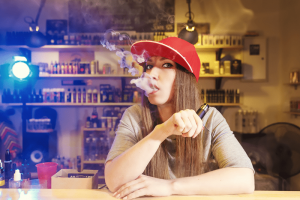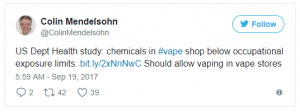Posted on September 21, 2017 in the "Reaver's VapE Blog" by reaversadmin
Have you ever thought about any health risks being in the "Vapour cloud effect" prominent in most VapE Stores?
Posted in
E-Cig's, Editorials, Technical aspects, Vaping
By Jim McDonald and Colin Hendelsohn
NIOSH tested the air in a busy vape shop and found…

A new report by a U.S. government agency says that their tests showed that levels of “vaping-related chemicals” in the air of a vape shop were all below workplace safety limits.
The National Institute for Occupational Safety and Health (NIOSH) issued the report — titled “Evaluation of Chemical Exposures at a Vape Shop” — in July, but the testing took place in January of 2016. The shop isn’t named in the report.
NIOSH is a division of the Centers for Disease Control and Prevention (CDC), an agency of the Department of Health and Human Services (HHS). Its stated mission is, “To develop new knowledge in the field of occupational safety and health and to transfer that knowledge into practice.” NIOSH says it has a mandate to assure “every man and woman in the Nation safe and healthful working conditions and to preserve our human resources.”
What were they looking for?

According to the report, NIOSH was asked to evaluate the shop by its owners. The agency’s “primary objective was to evaluate employees’ potential exposures to chemicals associated with
vaping in the shop.”
“Our work involved (1) sampling air for specific flavoring chemicals associated with respiratory disease; (2)sampling air for nicotine, propylene glycol, formaldehyde, and other VOCs [volatile organic compounds]; (3)sampling work surfaces for metals and nicotine; and (4) observing work practices.”
Oddly enough, we haven’t seen any CDC publicity about this report.
The shop sold both pre-packaged e-liquid brands, and their own juice made on site. The custom e-liquid was mixed at a juice bar by employees. The shop was about 1,000 square feet in size, had 10 employees, and was open during typical retail hours.
NIOSH took air samples at several locations within the shop, testing for the presence of diacetyl, acetyl propionyl (2,3-pentanedione), acetyl butyryl (2,3-hexanedione), acetaldehyde, acetoin, and formaldehyde. They also tested for nicotine, propylene glycol (PG), and volatile organic compunds (VOC’s) in the air, and collected samples from surfaces to measure metals.
What did they find?

The first thing they found was ridiculous: the employees kept nicotine base (100 mg/mL) in the refrigerator that also was home to food they ate. That should just never happen. And it really shouldn’t happen when a government agency is observing your routines. Employees also rarely wore gloves (which were present and available) when handling 100 mg/mL nic. Again, not wise.
As far as air samples…well, none of them even remotely approached the various exposure limits NIOSH compared to. Results varied, but overall there just wasn’t much to be said.
“The results for the area air samples taken over the entire work day in the juice bar and
lounge areas using silica gel tubes are presented in Table 3,” says the report. “Diacetyl, 2,3-pentanedione, 2,3-hexanedione, and acetoin were not detected in the lounge area. For the full-shift area air samples taken behind the juice bar using silica gel tubes, we found detectable, but not quantifiable, concentrations of 2,3-pentanedione on day 1.
We did not find detectable
concentrations of any of the other flavoring chemicals in the other juice bar samples.”
Formaldehyde was found in two of the eight samples at about half of the NIOSH recommended exposure level (REL). The rest of the samples were lower or not detectable. “Low concentrations of formaldehyde exist in many indoor environments because of off gassing from furnishings, clothing, and other materials,” they noted.
Nicotine measures came with an asterisk. “Estimated concentration; this concentration was between the minimum detectable and minimum quantifiable concentrations,” they said. In other words, the amount measured was too low to provide an accurate number.

Volatile organic compounds: “Employees exposures to all of the compounds quantified were well below OELs [occupational exposure limits].”
Metals: “Quantifiable concentrations of calcium (15–94 micrograms per 100 squared centimeters [µg/100 cm2 ]), copper (ND–0.49 µg/100 cm2 ), iron (ND–1.8 µg/100 cm2), and potassium (ND–17 µg/100 cm2) were identified in the wipe samples. Detectable, but not quantifiable, concentrations of chromium, lead, magnesium, nickel, phosphorus, strontium, and tellurium were also identified in some samples.”
“Some of the other elements that we detected on surfaces are found in human sweat (calcium, potassium, magnesium, and phosphorous),” they noted. “It is unknown if their presence on surfaces was from e-cigarettes, people touching surfaces, or both.”
NIOSH’s conclusions were pretty bland.
“Employees were exposed to detectable levels of diacetyl and 2,3-pentanedione in the air
while working in the vape shop,” they wrote. “Although the measured concentrations were below all applicable OELs, to better protect the health of employees we recommend that the employer implement a policy prohibiting vaping in the workplace with e-liquids that contain diacetyl and 2,3-pentanedione.
“The concentration of other vaping-related chemicals that we measured were also below their relevant OELs. Employees should be trained on proper chemical handling procedures and the need for consistent use of chemical protective nitrile gloves when handling liquids containing nicotine.”
No news is good news

Oddly enough, we haven’t seen any CDC publicity about this report. You’d think the CDC would want to share the good news that vapers and employees in vape shops aren’t endangering their health by breathing the vapor-laden air. No press releases or news conferences, no amending of the scare-mongering Surgeon General’s report from last year.
This adds to the evidence from earlier studies. There has never been any indication that breathing second hand e-cig vapor poses risks for vapers — let alone bystanders — but it’s nice to have confirmation from the usually anti-vaping CDC.
Related articles supplied courtesy of:
VAPING360,
Jim McDonald and
Colin Mendelsohn
Have you ever thought about any health risks being in the "Vapour cloud effect" prominent in most VapE Stores?
- Vapour's hanging in the VapE Shops air, do they pose any health threat to others i.e. employees and or clientele visiting the respective Vape Stores?
- "Related testing took place in January of 2016."
- The specific shop was not named in the report.
- The National Institute for Occupational Safety and Health (NIOSH) issued the report — titled “Evaluation of Chemical Exposures at a Vape Shop” — in July 2017.
- Tests carried out and the attached article below shed some light on the topic ....
Posted in
E-Cig's, Editorials, Technical aspects, Vaping
By Jim McDonald and Colin Hendelsohn
NIOSH tested the air in a busy vape shop and found…

A new report by a U.S. government agency says that their tests showed that levels of “vaping-related chemicals” in the air of a vape shop were all below workplace safety limits.
The National Institute for Occupational Safety and Health (NIOSH) issued the report — titled “Evaluation of Chemical Exposures at a Vape Shop” — in July, but the testing took place in January of 2016. The shop isn’t named in the report.
NIOSH is a division of the Centers for Disease Control and Prevention (CDC), an agency of the Department of Health and Human Services (HHS). Its stated mission is, “To develop new knowledge in the field of occupational safety and health and to transfer that knowledge into practice.” NIOSH says it has a mandate to assure “every man and woman in the Nation safe and healthful working conditions and to preserve our human resources.”
What were they looking for?

According to the report, NIOSH was asked to evaluate the shop by its owners. The agency’s “primary objective was to evaluate employees’ potential exposures to chemicals associated with
vaping in the shop.”
“Our work involved (1) sampling air for specific flavoring chemicals associated with respiratory disease; (2)sampling air for nicotine, propylene glycol, formaldehyde, and other VOCs [volatile organic compounds]; (3)sampling work surfaces for metals and nicotine; and (4) observing work practices.”
Oddly enough, we haven’t seen any CDC publicity about this report.
The shop sold both pre-packaged e-liquid brands, and their own juice made on site. The custom e-liquid was mixed at a juice bar by employees. The shop was about 1,000 square feet in size, had 10 employees, and was open during typical retail hours.
NIOSH took air samples at several locations within the shop, testing for the presence of diacetyl, acetyl propionyl (2,3-pentanedione), acetyl butyryl (2,3-hexanedione), acetaldehyde, acetoin, and formaldehyde. They also tested for nicotine, propylene glycol (PG), and volatile organic compunds (VOC’s) in the air, and collected samples from surfaces to measure metals.
What did they find?

The first thing they found was ridiculous: the employees kept nicotine base (100 mg/mL) in the refrigerator that also was home to food they ate. That should just never happen. And it really shouldn’t happen when a government agency is observing your routines. Employees also rarely wore gloves (which were present and available) when handling 100 mg/mL nic. Again, not wise.
As far as air samples…well, none of them even remotely approached the various exposure limits NIOSH compared to. Results varied, but overall there just wasn’t much to be said.
“The results for the area air samples taken over the entire work day in the juice bar and
lounge areas using silica gel tubes are presented in Table 3,” says the report. “Diacetyl, 2,3-pentanedione, 2,3-hexanedione, and acetoin were not detected in the lounge area. For the full-shift area air samples taken behind the juice bar using silica gel tubes, we found detectable, but not quantifiable, concentrations of 2,3-pentanedione on day 1.
We did not find detectable
concentrations of any of the other flavoring chemicals in the other juice bar samples.”
Formaldehyde was found in two of the eight samples at about half of the NIOSH recommended exposure level (REL). The rest of the samples were lower or not detectable. “Low concentrations of formaldehyde exist in many indoor environments because of off gassing from furnishings, clothing, and other materials,” they noted.
Nicotine measures came with an asterisk. “Estimated concentration; this concentration was between the minimum detectable and minimum quantifiable concentrations,” they said. In other words, the amount measured was too low to provide an accurate number.

Volatile organic compounds: “Employees exposures to all of the compounds quantified were well below OELs [occupational exposure limits].”
Metals: “Quantifiable concentrations of calcium (15–94 micrograms per 100 squared centimeters [µg/100 cm2 ]), copper (ND–0.49 µg/100 cm2 ), iron (ND–1.8 µg/100 cm2), and potassium (ND–17 µg/100 cm2) were identified in the wipe samples. Detectable, but not quantifiable, concentrations of chromium, lead, magnesium, nickel, phosphorus, strontium, and tellurium were also identified in some samples.”
“Some of the other elements that we detected on surfaces are found in human sweat (calcium, potassium, magnesium, and phosphorous),” they noted. “It is unknown if their presence on surfaces was from e-cigarettes, people touching surfaces, or both.”
NIOSH’s conclusions were pretty bland.
“Employees were exposed to detectable levels of diacetyl and 2,3-pentanedione in the air
while working in the vape shop,” they wrote. “Although the measured concentrations were below all applicable OELs, to better protect the health of employees we recommend that the employer implement a policy prohibiting vaping in the workplace with e-liquids that contain diacetyl and 2,3-pentanedione.
“The concentration of other vaping-related chemicals that we measured were also below their relevant OELs. Employees should be trained on proper chemical handling procedures and the need for consistent use of chemical protective nitrile gloves when handling liquids containing nicotine.”
No news is good news

Oddly enough, we haven’t seen any CDC publicity about this report. You’d think the CDC would want to share the good news that vapers and employees in vape shops aren’t endangering their health by breathing the vapor-laden air. No press releases or news conferences, no amending of the scare-mongering Surgeon General’s report from last year.
This adds to the evidence from earlier studies. There has never been any indication that breathing second hand e-cig vapor poses risks for vapers — let alone bystanders — but it’s nice to have confirmation from the usually anti-vaping CDC.
Related articles supplied courtesy of:
VAPING360,
Jim McDonald and
Colin Mendelsohn




